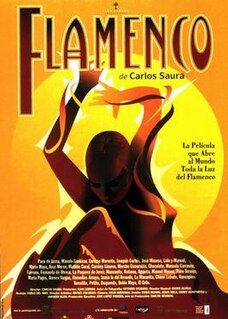
José Mercé is a Spanish flamenco singer (cantaor). As a 12-year-old he was already performing at Flamenco Festivals. Later he moved to Madrid where he recorded his first album in 1968.

Manuel Moreno Junquera, Moraíto Chico was a Flamenco guitarist.
New flamenco is synonymous with modern flamenco and is a derivative of traditional flamenco. It combines flamenco guitar virtuosity with musical fusion. Jazz, rumba, bossa nova, Gypsy, Latin, Middle Eastern, rock, Cuban swing, tango, salsa and especially blues have all been fused into flamenco by different artists to produce its sound.
Cante jondo is a vocal style in flamenco, an unspoiled form of Andalusian folk music. The name means "deep song" in Spanish, with hondo ("deep") spelled with J as a form of eye dialect, because traditional Andalusian pronunciation has retained an aspirated H lost in other forms of Spanish.

María Rosa García García better known as Niña Pastori is a Spanish flamenco singer (cantaora). She was born in San Fernando (Cádiz) on 15 January 1978.
Mayte Martín. She is a Flamenco cantaora (singer), bolero singer, and composer. She is widely recognized as one of the most important flamenco voices of her generation. She has also devoted part of her career to other genres such as Spanish American music, especially bolero.

A palo or cante is the name given in flamenco for the different traditional musical forms.

Pastora Pavón Cruz, known as La Niña de los Peines, is considered the most important woman flamenco singer of the 20th century. She was a sister of singers Arturo Pavón and Tomás Pavón, also an important flamenco singer, and aunt to Arturo Pavón, the first flamenco pianist. Both brothers, Pastora and Tomás, together with singer Manuel Torre, were the inspiring models for the next generation of singers like Antonio Mairena, Pepe de la Matrona or Fosforito, who led the movement towards the revival of traditional forms in the decades of the 50s-70s.
Cantes de ida y vuelta is a Spanish expression literally meaning roundtrip songs. It refers to a group of flamenco musical forms or palos with diverse musical features, which "travelled back" from Latin America as styles that, having originated in the interplay between Spanish musical traditions and those of the African slaves and Native Americans, developed into renewed forms that were reintroduced in Spain. Usually they have a more mellow character than the more traditional flamenco songs.
José Tejada Marín, known as Pepe Marchena and also as Niño de Marchena in the first years of his career, was a Spanish flamenco singer who achieved great success in the ópera flamenca period (1922–1956). Influenced by singers like Antonio Chacón, he carried to the extreme the tendency to a more mellow and ornamented style of flamenco singing. Owing to his particular vocal conditions and singing style, he excelled mainly in palos (styles) like fandangos, cantes de ida y vuelta and cantes libres, contributing to making them the most popular flamenco styles in the era of the ópera flamenca, and created a new cante de ida y vuelta, the colombiana, later recorded by many other artists like El Lebrijano or Enrique Morente. He was also the first flamenco singer to use an orchestra to accompany flamenco singing, though later he returned to the guitar.
Bambera is a cante, one of many traditional song forms associated with flamenco.

El Concurso del Cante Jondo was a well-known celebration of the art of flamenco, its music, song, and dance, held in Granada, Spain, on Corpus Christi, the 13th and 14 June 1922. At conception the idea of composer Manuel de Falla, its organizating activities enjoyed early and strong support from poet Federico García Lorca. The two outdoor, evening events included amateur flamenco performers, as well as revered professionals.

The saeta is a revered form of Spanish religious song, whose form and style has evolved over many centuries. Saetas evoke strong emotion and are sung most often during public processions.

Flamenco is a 1995 Spanish documentary film directed by Carlos Saura with camerawork by cinematographer Vittorio Storaro. The film is entirely musical and dancing vignettes, composed and photographed on a sound stage.

The Teatro de la Zarzuela is a theatre in Madrid, Spain. The theatre is today mainly devoted to zarzuela, as well as operetta and recitals.

Paco de Lucía interpreta a Manuel de Falla is the twelfth studio album by the Spanish composer and guitarist Paco de Lucía. All the pieces were written by Manuel de Falla.

El duende flamenco de Paco de Lucía is the eighth studio album by the Spanish composer and guitarist Paco de Lucía. All songs were written by Paco de Lucía.
Ramón Sánchez Gómez, better known by his stage name Ramón de Algeciras, was a Spanish flamenco guitarist, composer and lyricist. He was the most prolific collaborator of Paco de Lucía, his younger brother, recording with him on most of his albums from the 1960s to 1980s and performing with him throughout much of his life as a rhythm guitarist, including the Paco de Lucía Sextet, formed in 1981, which also included his other brother Pepe de Lucía.












